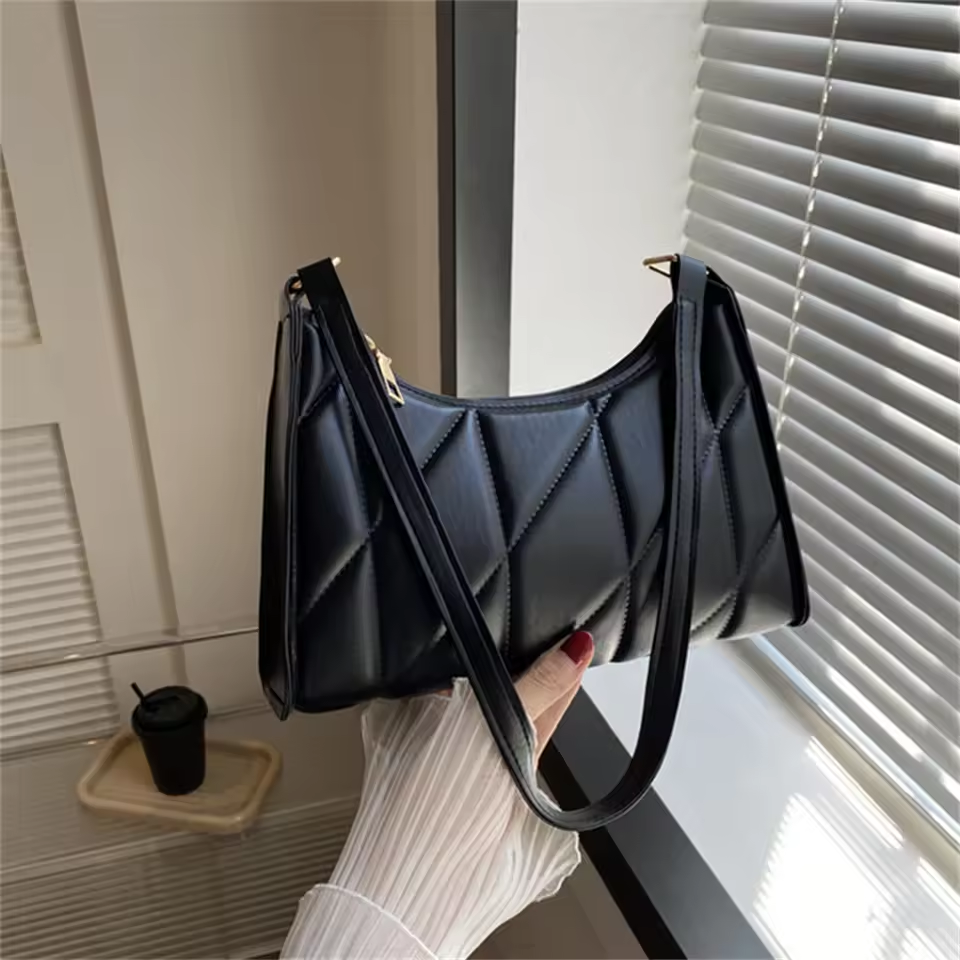Introduction to Rubber Beach Bags
A rubber beach bag is a modern, eco-friendly alternative to traditional canvas or plastic bags, designed for adventure and sustainability. Crafted from natural or recycled rubber, these bags combine durability with environmental responsibility. Their waterproof, UV-resistant construction makes them ideal for beach trips, where they keep sand and saltwater at bay, while their lightweight yet sturdy design accommodates everything from towels to sunscreen. Beyond the shore, they excel as grocery totes, travel organizers, or even stylish home storage solutions. Easy to clean (just rinse with water!), they require minimal maintenance and last years longer than disposable alternatives. As a versatile, low-impact choice, the rubber beach bag appeals to anyone prioritizing sustainability without sacrificing style or practicality. Discover the benefits of this innovative accessory and join the movement toward eco-conscious living.
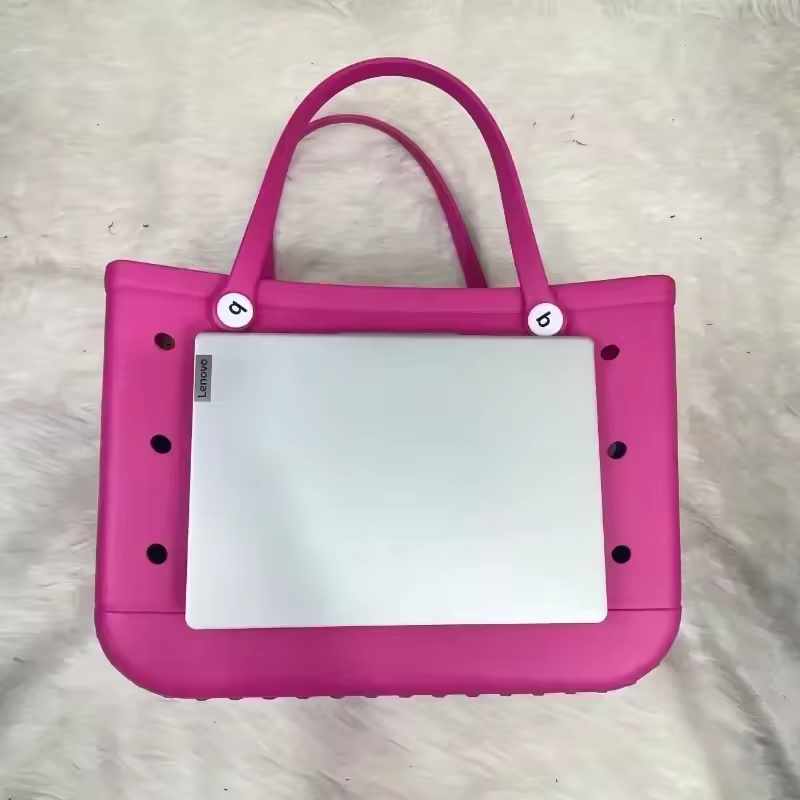
Why Choose a Rubber Beach Bag Over Traditional Materials?
A rubber beach bag surpasses conventional options like plastic, canvas, or polyester in sustainability, durability, and practicality. Here’s why it’s the smarter choice:
1. Eco-Conscious Design
Rubber bags are made from natural or recycled materials, reducing plastic waste and minimizing environmental harm. Unlike single-use plastics or cotton, rubber is biodegradable and recyclable. Synthetic alternatives often shed microplastics, but rubber avoids this issue entirely.
2. Unmatched Durability
Rubber’s flexibility and strength outlast traditional fabrics. While canvas tears under heavy loads and plastic bags degrade in sunlight, a rubber beach bag resists abrasion, UV rays, and repeated use. Its reinforced structure handles rugged adventures without fraying or puncturing.
3. Waterproof & Stain-Resistant
Beaches, rainstorms, or spills won’t damage rubber. Unlike absorbent fabrics that mildew, rubber stays dry inside, shielding contents like electronics or documents.
4. Low-Maintenance Care
Cleaning requires just a quick rinse—no detergents or drying cycles. Traditional fabrics demand frequent washing, while rubber’s antimicrobial properties keep it fresh naturally.
5. Versatile Functionality
A rubber beach bag adapts to any scenario: beach trips, grocery runs, travel packing, or even home storage. Its weatherproof, lightweight design works for casual and professional use, unlike plastic’s limited utility or canvas’s fragility.
Traditional materials often sacrifice one or more of these traits. Rubber combines longevity, eco-friendliness, and reliability into one versatile, cost-effective solution.
Key Features of a High-Quality Rubber Beach Bag
A high-quality rubber beach bag distinguishes itself through thoughtful design, superior materials, and practical functionality. Here are the features to prioritize when choosing one:
- Material Composition: Opt for bags made from natural rubber or recycled rubber blends, which ensure biodegradability and reduce environmental impact. Avoid synthetic alternatives that may release harmful chemicals.
- Reinforced Construction: Look for double-stitched seams, thick rubber layers, and durable handles to prevent tearing or breaking, even under heavy loads. Some designs include non-slip grips for comfort during prolonged use.
- Waterproof & UV-Resistant Coating: A high-quality bag features a coated exterior to repel water, salt, and sand, while UV protection prevents fading or hardening from sunlight exposure.
- Organizational Design: Spacious interiors with separate pockets and adjustable straps enhance usability, whether packing towels, snacks, or essentials for travel.
- Lightweight Portability: Despite its durability, a good rubber beach bag remains lightweight, making it easy to carry or fold into a compact size for storage.
- Eco-Certifications: Seek products with certifications like Fair Trade or Carbon Neutral to ensure ethical sourcing and production practices.
- Aesthetic Appeal: Durable yet stylish, top-tier bags offer neutral tones or bold colors/patterns that resist fading, ensuring they stay fashionable over years of use.
By prioritizing these features, a high-quality rubber beach bag becomes a reliable, long-lasting investment for beach trips, outdoor adventures, or everyday tasks—outperforming flimsy plastic or low-quality fabric alternatives.
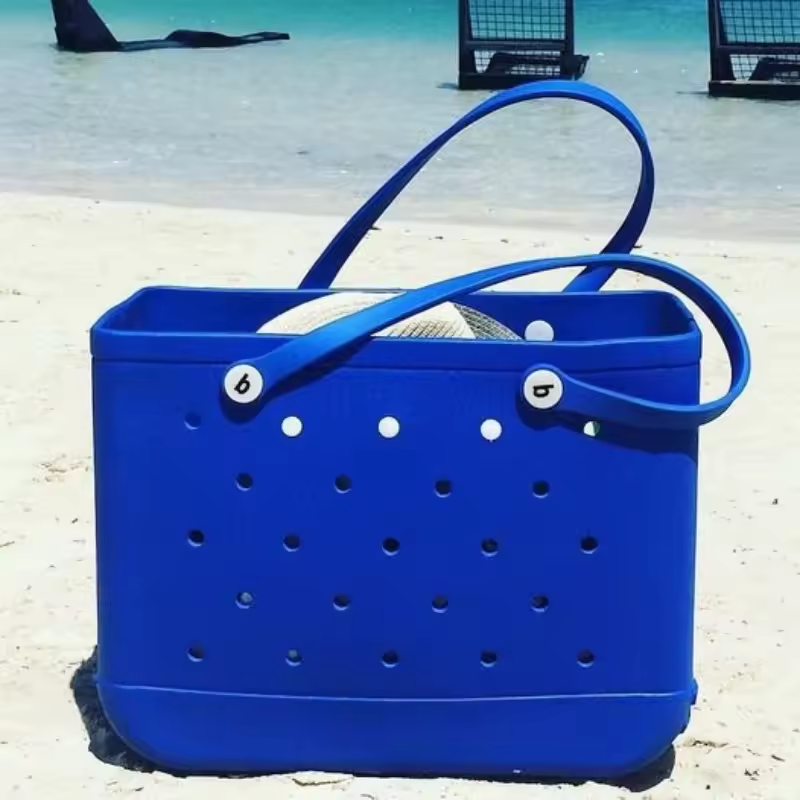
How to Use a Rubber Beach Bag Beyond the Beach
While designed for coastal adventures, a rubber beach bag is a remarkably versatile accessory that transcends its name. Its durability, waterproofing, and minimalist design make it ideal for everyday and unconventional uses:
- Grocery Shopping: Its waterproof material keeps groceries dry in sudden rain, while its sturdy construction handles heavy produce.
- Travel Packing: Use it as a toiletry organizer (no leaks from toiletries) or a shoe/clothing compartment in luggage to prevent soiling other items.
- Outdoor Workouts: Carry yoga mats, water bottles, or gym clothes without worrying about sweat or rain damaging the bag.
- Pet Accessories: Store leashes, toys, or waste bags during walks, as rubber resists odors and stains.
- Home Storage: Repurpose it as a laundry hamper (odor-resistant), tool bin, or even a shoe rack thanks to its open structure.
- Event Carrying: Perfect for farmers’ markets, festivals, or concerts—its lightweight frame holds snacks, blankets, or gear without bulk.
- Emergency Kit Holder: Store first-aid supplies, rain ponchos, or flashlights in its secure, waterproof interior.
The rubber beach bag’s adaptability lies in its resilience and simplicity. Whether tackling daily errands or unexpected scenarios, it combines practicality with eco-friendliness, proving it’s a must-have for any sustainable lifestyle.
Maintenance and Longevity Tips for Your Bag
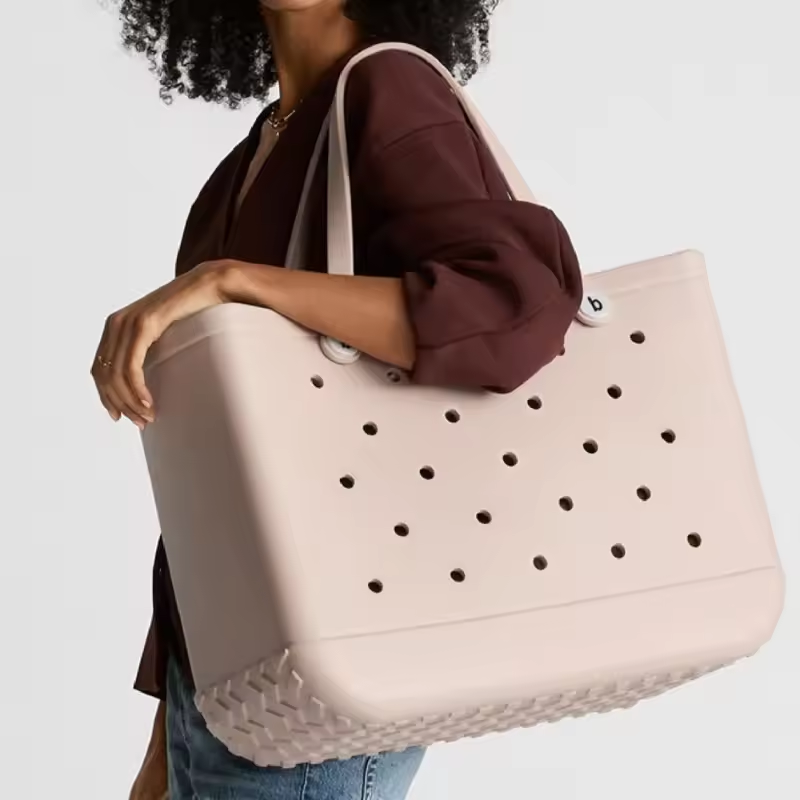
Proper care ensures your rubber beach bag remains durable, stain-free, and functional for years. Follow these steps to maximize its lifespan:
- Regular Cleaning:
- After Use: Rinse with cold water to remove sand, salt, or sunscreen. Avoid hot water, which can soften rubber.
- Stubborn Stains: Gently scrub with a soft brush and mild soap (no bleach). Rinse thoroughly and air-dry.
- Storage Tips:
- Avoid Direct Sunlight: Prolonged UV exposure weakens rubber, causing cracks. Store in a cool, dry place like a closet.
- Fold or Hang: Never crush it under heavy objects; store loosely folded or hung to prevent creasing.
- Check for Damage:
Inspect seams, handles, and zippers monthly. Address tears or frayed edges promptly—many brands offer repair kits or services. - Avoid Overloading:
While sturdy, excessive weight (e.g., heavy tools) may strain the material. Distribute items evenly and stay within the bag’s weight limit. - Seasonal Care:
Before storing for long periods (e.g., winter), ensure it’s completely dry to prevent mold. Apply a thin layer of coconut oil to maintain flexibility (optional). - No Chemicals:
Harsh detergents or solvents degrade rubber. Stick to water and mild soap for cleaning.
By following these tips, your rubber beach bag resists wear, maintains its shape, and stays eco-friendly—proving it’s a worthwhile investment over disposable alternatives.
Addressing Common Concerns About Rubber Materials
Potential buyers often hesitate about rubber beach bags due to misconceptions. Here’s a breakdown of common concerns and clarifications:
- “Does rubber smell?”
High-quality bags made from natural rubber (e.g., Hevea) have little to no odor. Unpleasant smells usually signal low-quality synthetic blends or poor curing processes. Opt for brands with transparent material sourcing. - “Is it heavy?”
Modern designs prioritize lightweight construction. While thicker rubber adds durability, advancements in material science ensure minimal weight—far lighter than you’d expect for such strength. - “Can it hold heavy items?”
Yes! Reinforced stitching and rubber layers support loads of 30–50 lbs. Test the bag’s weight limit (listed by brands) to avoid overstraining. - “Does it attract insects?”
Unlike fabric, rubber repels pests. Its non-porous surface doesn’t retain odors that attract insects, making it ideal for outdoor use. - “Is it truly eco-friendly?”
Natural rubber is biodegradable, and recycled blends reduce plastic waste. Avoid bags with PVC additives—opt for certifications like Fair Trade or Cradle to Cradle for transparency. - “Does it degrade in sunlight?”
UV-resistant coatings protect against hardening or fading. Store it in shaded areas when not in use to maintain flexibility.
By choosing a well-made rubber beach bag, you gain a durable, odor-free, and sustainable option that outperforms traditional materials—without compromising on style or function.
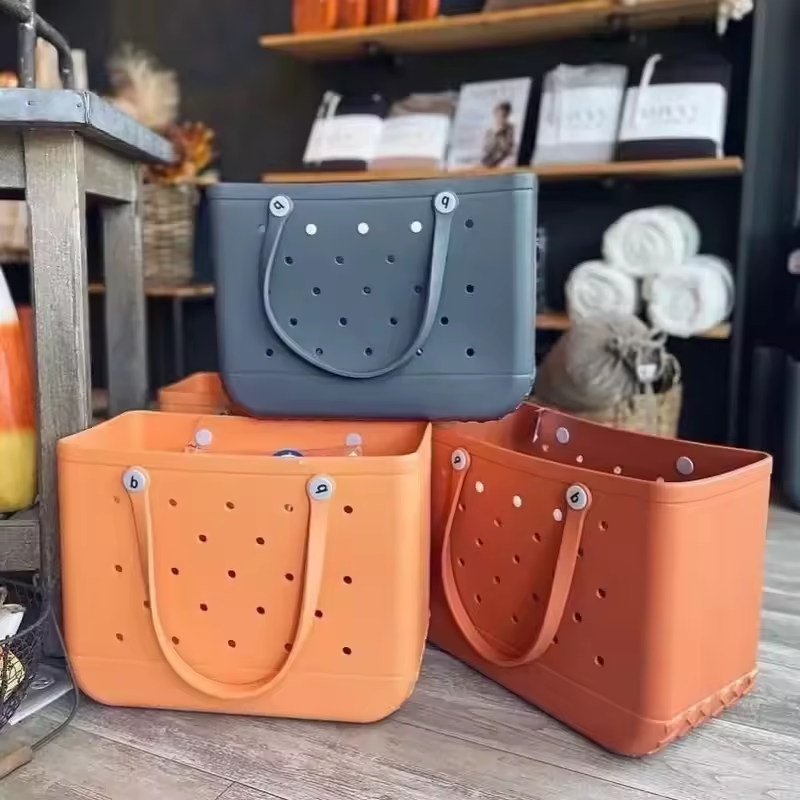
Stylish Designs That Match Any Lifestyle
A rubber beach bag isn’t just functional—it’s a canvas for style. Modern designs cater to diverse tastes, ensuring it complements any aesthetic or lifestyle:
- Neutral Tones for Timeless Elegance
Earthy browns, whites, or blacks pair effortlessly with formal outfits or casual wear. These colors blend into professional settings (e.g., carrying a laptop to meetings) while maintaining a beach-ready vibe. - Bold Colors & Patterns for Bold Personalities
Vibrant hues like cobalt blue, coral, or mustard yellow add a playful touch. Geometric prints, floral motifs, or abstract art designs let you express creativity—ideal for festivals, weekend getaways, or eco-conscious fashion statements. - Minimalist Chic
Clean lines and monochrome palettes suit minimalist styles. A sleek, unembellished rubber beach bag works as a polished accessory for urban commutes, gallery visits, or meetings. - Customizable Options
Brands offer personalized touches like embroidered initials, monograms, or interchangeable straps. This makes the bag a unique, personalized gift or a statement piece. - Retro & Nostalgic Themes
Bags with vintage-inspired patterns (e.g., 70s florals or retro slogans) appeal to those seeking nostalgia. These designs pair well with bohemian outfits or coastal home decor. - Adventure-Ready Camouflage
For outdoor enthusiasts, military-style or leaf-patterned bags blend into nature while staying functional—perfect for hiking, camping, or trail runs.
The versatility of a rubber beach bag lies in its adaptability. Whether you’re a minimalist, a fashionista, or an adventurer, its designs transition seamlessly from beaches to boardrooms, proving sustainability and style aren’t mutually exclusive.
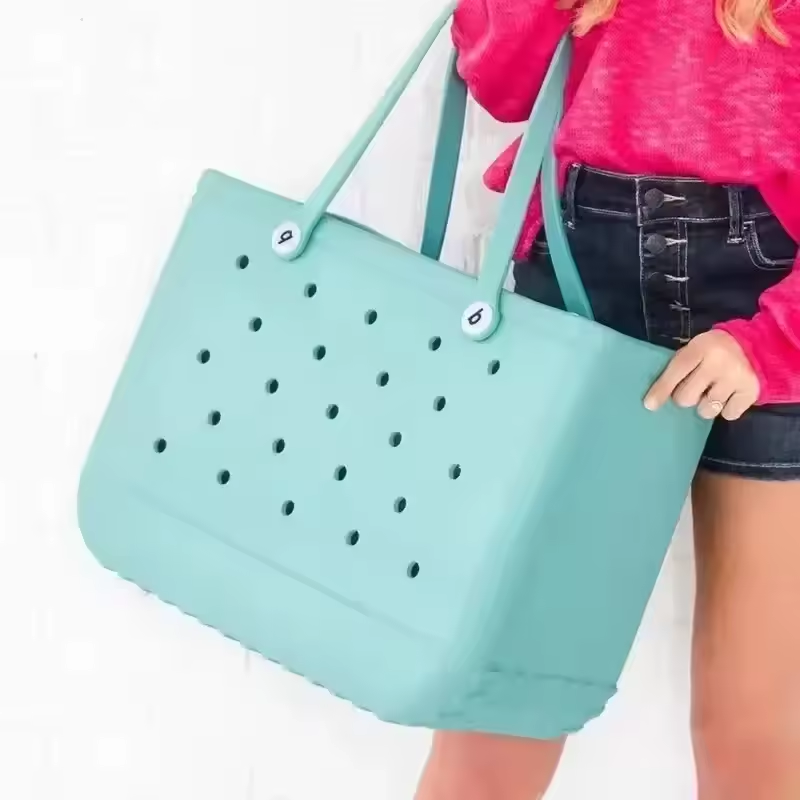
FAQs About Rubber Beach Bags
Q: Is a rubber beach bag truly eco-friendly?
Yes! Most are made from natural rubber (biodegradable) or recycled materials, reducing plastic waste. Look for certifications like Fair Trade or Cradle to Cradle for transparency.
Q: Does it smell like rubber?
High-quality bags made from natural rubber have minimal odor. Unpleasant smells usually indicate low-quality materials—opt for brands with ethical sourcing.
Q: Is it heavy to carry?
No! Modern designs balance durability and lightweight construction. Most weigh under 0.5 kg, making them easy to carry even when full.
Q: Can it hold heavy items like laptops?
Absolutely! Reinforced seams and thick rubber layers support loads of 30–50 lbs. Check the brand’s weight limit for safety.
Q: Does it attract insects or pests?
No. Unlike fabric, rubber’s non-porous surface repels odors and pests, making it ideal for outdoor use.
Q: How long does it last?
With proper care (regular cleaning, avoiding extreme heat), a rubber beach bag lasts 5–10 years—far longer than plastic or canvas alternatives.
Q: Can I machine-wash it?
Hand-washing is safest, but some brands offer dishwasher-safe options. Avoid hot water to prevent material damage.
By addressing these concerns, the rubber beach bag proves itself as a durable, stylish, and sustainable choice for every adventure.
